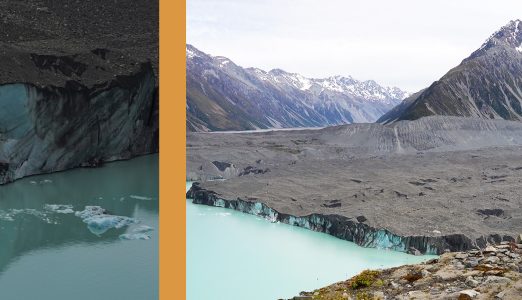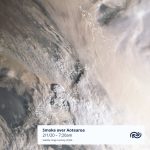
A post-human understanding of anthropogenic landscapes- bookending the 2020 Australian summer fires between the sonic memories of the lyrebirds and the reflective properties of ice.
Considering these two landscapes, connected now by the ash from the fires, embedded in glacial ice. To reflect one within the other; the birds narration of its bush, echoed to the NZ glacier landscape of the NZ Southern Alps / Kā Tiritiri o te Moana.

The Balangara / Dyagula/ Menura novaehollandiae/ superb lyrebird sings the song of many birds. Lyrebirds are excellent mimics, performing a sonic recollection of all the birdlife in the forest around them; the oral historians and narrators of the bush. Their mimicry skills are profound that other bird species can’t tell the difference between lyrebird mimicry and their own species’ calls.
They are also one of the greatest ecosystem engineers, moving more soil than any other land animal on Earth, as they feed in the undergrowth.
The Black Summer fires of eastern Australia (2019-220) was the worst in recorded history. It burned over 512,000 hectares of trees, killed or displaced 3 million animals and took 3 months to fully contain.
For 12 months across 2020 I mapped the post-fire lands of the worst affected areas, on Gundungurra and Darug country, returning to the same sites to document the growth of the new anthropogenic, post-fire forest.
For more on that project: HERE
50% of lyrebirds along the east coast NSW were lost in the 2020 fires: burned or subsequently starved, and all of their sonic memories of the valleys gone.
At the peak of the 2020 bushfires, ash from the fires was blown across the Tasman Sea and covered the Southern Alps of New Zealand/ Kā Tiritiri o te Moana. The mountains were covered a dusky pinkish colour. The forests of the lyrebirds brought, unasked, to the glaciers of Kā Tiritiri o te Moana.
Researchers in New Zealand are looking at the future impact of ash (from hotter drier Australian summers) on the melting of NZ glaciers, through decreased reflectivity and increased snow algae.
It was calculated the ash of these fires covered 90% of the total glaciated area of the NZ South Island. They projected the impact of the ash on snow melt across 2020 exceeded that of climate warming since preindustrial periods. An ashfall in place of a snowfall, to darken the snow.
We are contaminated by our encounters…’ writes Anthropologist Anna Tsing


Of tongues and tongues; glacier and bird. Of glacial faces and glacial heads, and avian voices and forest ears.


Glaciers sit on the edge of mountains, entirely at the grace of atmospheric temperatures. Glaciologists talk about firn lines and ablation zones, to demark with almost-poetic terms the tipping point where melting losses exceed snowfall accumulation from higher up the glacier. These glaciers are like aquatic ghosts of the Pleistocene, as they follow deep-time ice-carved memories down the mountain. Modelling indicates most glaciers in the world will be gone within 60 years, and the histories of past atmospheres contained within their days, seasons and years of ice.
In 2022 the researchers from Victoria University, Wellington and Manaaki Whenua Landcare Research NZ undertook the first measurement of the impact of Australian bushfire ash on the snow albedo. They had collect the fallen ash from the glacial snow two years earlier, in February 2020, worried at the time that the ash would wash away, and that more needed to be studied. At the heart of every good scientist is a speculative artist.
I circled around Haupapa, playing the the songs of lyrebirds from before the fires to its glaciers, the same sites the scientists had spread and studied the bushfire ash.
The researchers are also studying snow algae; existing in senescence in the ice until they sense a slight increase in temperature from seasonal change, or from dust or ash increasing the surface temperature of the icepack.
On awakening, the algae express a pigment that absorbs solar radiation, creating micromelts, enabling algal replication. Miniature geo-engineers.
L: Field work with scientists. With thanks to Manaaki Whenua–Landcare Research
More about glacial loss see Think Like a Mountain: HERE
Hear us, you who are no more than leaves always falling, you mortals benighted by nature, You enfeebled and powerless creatures of earth always haunting a world of mere shadows, Entities without wings, insubstantial as dreams, you ephemeral things, you human beings: Turn your minds to our words, our ethereal words, for the words of the birds last forever!
—Aristophanes, The Birds
References and notes :
Lyrebird sounds and footage collected primarily from Dharug and Gundungurra country/ Blue Mountains, on which much of the fires occurred.
With thanks to JJ Emerson for footage and sound.
With thanks to Dr Phil Novis + Dr John Hunt and Manaaki Whenua – Landcare Research, Lincoln NZ
The Maori storytellings of the NZ glaciers are so profoundly and beautifully embodied- they talk of the Breath/ Hau of the Haupapa / Tasman glacier and the Tears of Hine Hukatere (Franz Joseph Glacier/ Kā Roimata o Hine Hukatere). There is more I need to understand in this.
With thanks for support from Blue Mountains World Heritage Institute
References:
Leks: More accurately described by animal behaviouralists as ‘lek-like’.
Unreliable narrators: Term coined by Dr Anastasia Dalziel
Anna Lowenhaupt Tsing, The Mushroom at the End of the World: On the Possibility of Life in Capitalist Ruins, 2015. Princeton
Anastasia H. Dalziell*, Robert D. Magrath, 2012. Fooling the experts: accurate vocal mimicry in the song of the superb lyrebird, Menura novaehollandiae. Animal Behaviour 83 (2012) pp. 1401-1410
Anastasia H Dalziell, The ecology of vocal mimicry in the superb lyrebird, Menura novahollandiae PHD Thesis, 2012. fig 3.1 p 75.
Birdlife Australia
Nicolas J. Cullen et al, 2017. An 11-year record of mass balance of Brewster Glacier, New Zealand, determined using a geostatistical approach. Journal of Glaciology (2017), 63(238) 199–217
Wei Pu et al, 2021. Unprecedented snow darkening and melting in New Zealand due to 2019-20220 Australian wildfires. m5GeSdc; May 4, 2021;15:15
Dr Christian Yarlequé, personal dataset, Instituto Nacional de Investigación en Glaciares y Ecosistemas de Montaña INAIGEM, Peru













